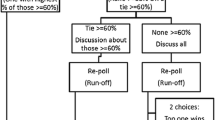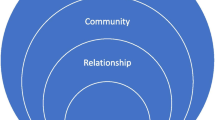Abstract
Addressing complex chronic disease prevention, like childhood obesity, requires a multi-level, multi-component culturally relevant approach with broad reach. Models are lacking to guide fidelity monitoring across multiple levels, components, and sites engaged in such interventions. The aim of this study is to describe the fidelity-monitoring approach of The Children’s Healthy Living (CHL) Program, a multi-level multi-component intervention in five Pacific jurisdictions. A fidelity-monitoring rubric was developed. About halfway during the intervention, community partners were randomly selected and interviewed independently by local CHL staff and by Coordinating Center representatives to assess treatment fidelity. Ratings were compared and discussed by local and Coordinating Center staff. There was good agreement between the teams (Kappa = 0.50, p < 0.001), and intervention improvement opportunities were identified through data review and group discussion. Fidelity for the multi-level, multi-component, multi-site CHL intervention was successfully assessed, identifying adaptations as well as ways to improve intervention delivery prior to the end of the intervention.
Similar content being viewed by others
References
Huang TT, DrewnoskI A, Kumanyika S, et al. A systems-oriented multi-level framework for addressing obesity in the 21st century. Preventing Chronic Disease. 2009; 6(3): A82.
Cohen DJ, Crabtree BF, Etz RS, et al. Fidelity versus flexibility: translating evidence-based research into practice. Am J Prev Med. 2008; 35(5 Suppl): S381-9. doi:10.1016/j.amepre.2008.08.005.
Novotny R, Fialkowski MK, Areta A, et al. The Pacific way to child wellness: The Children’s Healthy Living Program for Remote Underserved Minority Populations of the Pacific Region (CHL). Hawai‘i J Med Public Health. 2013; 72: 406-408.
Novotny R, Fialkowski MK, Li F et al. Systematic review of prevalence of young child overweight and obesity in the United States–Affiliated Pacific Region compared with the 48 contiguous states: The Children’s Healthy Living Program. Am J Public Health. 2014 epub ahead of print 2014: E1–E14. doi:10.2105/AJPH.2014.302283).
Braun KL, Nigg CR, Butel J, et al. Using the ANGELO framework to develop the Children’s Healthy Living Program multi-level intervention to promote obesity-preventing behaviors for young children in the US Affiliated Pacific Region. Childhood Obesity. In press.
Fialkowski MK, DeBaryshe B, Bersamin A, et al. A community engagement process identifies environmental priorities to prevent early childhood obesity: the Children’s Healthy Living (CHL) Program for Remote Underserved Populations in the US Affiliated Pacific Islands, Hawai‘i and Alaska. Matern Child Health J. 2014; 18: 2261-2274.
Wilken LR, Novotny R, Fialkowski MK, et al. Children’s Healthy Living (CHL) Program for Remote Underserved Minority Populations in the Pacific Region: rationale and design of a community randomized trial to prevent early childhood obesity. BMC Public Health. 2013; 13: 944-956.
Glasgow RE, Lichenstein E, Marcus AC. Why don’t we see more translation of health promotion research to practice? Rethinking the efficacy-to-effectiveness transition. Am J Public Health. 2003; 93: 1261-1267.
Dobson KS, Singer AR. Definitional and practical issues in the assessment of treatment fidelity. Clin Psychol Rev. 2005; 12: 384-387.
Sanchez V, Steckler A, Nitirat P, Hallfors D, Cho H, Brodish P. Fidelity of implementation in a treatment effectiveness trial of reconnecting youth. Health Educ Res. 2007; 22: 95-107.
Cleary M, Mackey S, Hunt GE, Jackson D, Thompson GE, Walter G. Reputations: a critical yet neglected area of scholarly inquiry. J Adv Nurs. 2012; 68(10): 2137-2139.
Valentine JC, Cooper H. A systematic and transparent approach for assessing the methodological quality of intervention effectiveness research: the Study Design and Implementation Assessment Device (Study DIAD). Psychol Methods. 2008; 13(2): 130-149.
Richard L, Potvin L, Kishchuk N, Prlic H, Green LW. Assessment of the integration of the ecological approach in health promotion programs. Am J Health Promot. 1996; 10(4): 318-328.
Richards Z, Kostadinov I, Jones M, Richard L, Cargo M. Assessing implementation fidelity and adaptation in a community-based childhood obesity prevention intervention. Health Educ Res. 2014; 29(6): 918-932.
Gearing RE, El-Bassel N, Ghesquiere A, Baldwin S, Gillies J, Ngeow E. Major ingredients of fidelity: a review and scientific guide to improving quality of intervention research implementation. Clin Psychol Rev. 2011; 31(1): 79-88. doi:10.1016/j.cpr.2010.09.007.
Waters E, de Silva-Sanigorski A, Hall BJ et al.. Interventions for preventing obesity in children. Cochrane Database Syst Reviews.2011; 11.
Foto KF, Moodie MM, Mavoa HM, et al. Process evaluation of a community-based adolescent obesity prevention project in Tonga. BMC Public Health. 2011; 11: 284.
Joffres C, Heath S, Farquharson J, et al. Facilitators and challenges to organizational capacity building in heart health promotion. Qual Health Res. 2004; 14: 39-60.
Officer SD, Price MF. Using visual reflection tools to build capacity for partnership improvement. Presented at Center for Service and Learning, IUPUI. Indianapolis, Indiana; 2012.
Acknowledgments
Financial support for the CHL Program is provided by the Agriculture and Food Research Initiative (grant no.: 2011-68001-30335) from the USDA National Institute of Food and Agriculture, a coordinated agricultural program.
Conflict of interest
All Authors declare that they have no conflicts of interest to report.
Adherence to ethical standards
All procedures followed were in accordance with the ethical standards of the responsible committee on human experimentation (institutional and national) and with the Helsinki Declaration of 1975, as revised in 2000. Informed consent was obtained from all patients for being included in the study.
Conflict of interest
All authors declare that they have no conflicts of interest to report.
Author information
Authors and Affiliations
Corresponding author
Additional information
Implication
Practice: Assessing implementation fidelity while activities are being conducted can identify program adaptations to fit local context as well as fidelity.
Research: Protocols to evaluate implementation fidelity of complex interventions need to be developed early, follow a coding model, and be adapted to fit the local context.
Policy: For community-driven programs, sufficient time needs to be allocated to build and develop relationships.
About this article
Cite this article
Butel, J., Braun, K.L., Novotny, R. et al. Assessing intervention fidelity in a multi-level, multi-component, multi-site program: the Children’s Healthy Living (CHL) program. Behav. Med. Pract. Policy Res. 5, 460–469 (2015). https://doi.org/10.1007/s13142-015-0334-z
Published:
Issue Date:
DOI: https://doi.org/10.1007/s13142-015-0334-z




